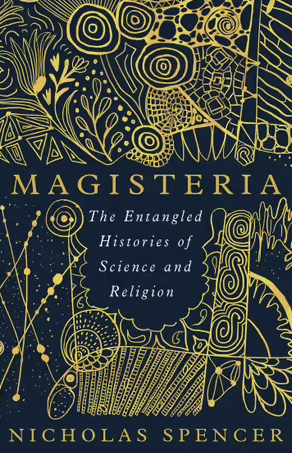Reviews: Magisteria: The Entangled Histories of Science and Religion, Nicholas Spencer | Light in the Darkness: Black Holes, the Universe and Us, Heino Falcke
When I was young, I was told that the Grand Canyon was a result of the biblical Flood, evolution was a false theory that Darwin had rejected on his deathbed and that there were no immediate fossils showing the mutability of species. It was not so much that people in my church were anti-science, it was that they felt the Bible was the ultimate authority, and in their reading, much contemporary so-called science was incompatible with it and atheists simply used these theories to discredit religious faith.

There is a long history of this conflict, largely over who gets to say, who has the authority. In response, Stephen Jay Gould famously coined the phrase ‘non-overlapping magisteria’ to describe religion and science, to indicate two separate areas of jurisdiction, rather than competing authorities. Gould wasn’t suggesting they don’t overlap, only that they shouldn’t, but it’s not entirely clear how that can work even in theory. This is especially, but not exclusively, the case in relation to the place of humanity – the Bible gives humans a special status while atheism often drives the argument that we are no different to other animals (contrary to simple observation).
Nicholas Spencer sees the question of authority as central to the historical relationship of science and religion, but he sees it as neither just conflict nor harmony. The story is, well, complicated. He writes, firstly, that it is wrong to think of the two as incompatible, but then again it is a mistake to read some current consensus (in some quarters) into the Bible. The Bible shows the (limited) scientific outlook of the time and doesn’t hide insights into, say, quantum physics. Saint Augustine said it was ‘embarrassing’ for Christians to talk about matters they had limited experience in.
‘Magisteria’ may suggest harmony and complementarity, but ‘entangled’ is the better word. People will use science against religion and vice versa. Georges Lemaitre, a Jesuit astronomer and friend of Einstein who theorised an expanding universe, therefore pointing to a ‘Big Bang’, seemed to favour complementarity. Despite being in a religious order, he warned his superiors not to assume that his findings ‘proved’ the Genesis account. But then there is that giant of science, Isaac Newton. Newton’s religious concerns were bigger than his astronomical ones, and he used the latter to boost the former, claiming that the laws and structure of the universe were proof of God. Recent work on his religious writings established that the magisteria were entangled in Newton’s mind.
A supposed history of conflict, as Spencer says, revolves around key events – Galileo’s confrontation with the church, Darwin and the Huxley-Wilberforce debate, the Scopes trial – bolstered by propaganda works that talked all this up. The histories are more complex – Galileo’s ego and brashness was as much the cause of friction as his theories; the Scopes trial was a particularly political event, as much about the perennial American antagonism of local and national authorities as it was about pure science.
Throughout Spencer’s book we are nudged in one direction, only to be pulled back the other, in order to see two sides. Darwin is a case in point – later in life he expressed agnosticism, driven as much as anything by the death of a favourite daughter. But he wrote to one colleague that a creator/designer was an inevitable conclusion from observation of the world. This wasn’t a deathbed conversion; it was an acknowledgment of compatibility. Thomas Huxley, ‘Darwin’s bulldog’, thought the supposed conflict ‘fabricated’, and his beef was with ‘short-sighted’ people, both religious and scientific. Huxley was anti-authoritarian, and an anti-anti-evolutionist, rather than anti-religious. Arguing for the professionalism to which he aspired, Huxley wanted science, not mere sentiment, to decide on the merit of evolutionary theory.
As well as being his own worst enemy, Galileo ran up against the authority of Greeks such as Aristotle, whose wild speculations were taken as gospel. Theologically they made some sense, but there was little biblical basis for his cosmological system. Acceptance of this system wasn’t about the privilege of humans – the church put the earth at the bottom of the geocentric system, corruptible, unlike the perfect heavens, but it was about a long-standing consensus about the order of the cosmos.

There were many who questioned this reliance on the Greeks, including Martin Luther. William of Conches argued that it was the meaning not the means that was important in terms of the picture of the cosmos. Calvin, using not exactly these words, argued that the Bible wasn’t a scientific textbook. Luther, too, thought scientific inquiry a worthy exercise, though Luther provides evidence that it was complicated even within individuals – he also called Copernicus a ‘fool’ for going against what Luther considered the plain sense of the Bible.
Thus far, we have been speaking of Christianity and Western science, but looking wider, the picture is more complicated. Islam had a ‘golden age’ of inquiry where Greek philosophy was welcomed, but the history is chequered. There is criticism of evolutionary theory within Islam, not because of the timeframes, but because of its supposed decentring of humans. The Jewish Bible is inconsistent, or at least polyphonic. In some places we see a picture of God in control of the world, with a harmonious nature showing the nature of God. Elsewhere, there is drama, chaos; God seems inscrutable, and nature emptied of meaning.
Lest we see science as purely forward momentum, a rushing into the future, unstoppable, dispelling darkness in favour of light, Spencer offers phrenology as an example of science derailing, or at least getting sidetracked. Phrenology, the now completely discredited idea of reading personalities from cranial shapes, dominated the nineteenth century, and has a dark history of racism, to which Darwinism was also hitched. Sections of the church resisted phrenology on these grounds.
Then there is resistance amongst scientists to theories that are now accepted, for reasons other than scientific. Yorkshireman and atheist Fred Hoyle criticised the Big Bang theory partly because it seemed sympathetic to the Genesis creation account and partly because the theory was pushed by elite southerners. In the Soviet Union, while materialism necessitated a rejection of religion, evolutionary theory was also rejected because it was a Western idea, and seemed, to them, to be consistent with the idea of a deity directing nature. The prominence of Creationism and then Intelligent Design in the United States particularly is driven by the mistaken assumption that an alternative science must be found to Darwinism and mainstream geology because these are completely incompatible with upholding the authority of the Bible.
The compatibility of science and religion is exemplified by those prominent scientists who also have religious belief, of whom Heino Falcke is one. Falcke is a German astrophysicist who headed the team that made the first image of a black hole. Made rather than took is the right word, as in 2019 the team complied data from telescopes working simultaneously around the world, to get around distortion from stars and interstellar dust, and synthesised an image of the black hole at the centre of nearby M87 galaxy, billions of times heavier than our sun. The image showed a halo of light (being spun around the hole at fantastic speeds) and the hole’s shadow. (Technically, we see the shadow, not the hole itself.) The light is bent so much, if you could possibly stand at the edge of a black hole and look along the edge, you’d see the back of your head – the light is spun in a circle because of the hole’s enormous gravity.
Falcke’s book is about the long process of observing, collating data and verifying if the image is really of a black hole, but he also writes about his faith. He is curious about the questions ‘beyond’ physics that religion and the existence of God answer. After-all, all material explanations of the origins of the universe still point to something not nothing, such as quantum foam. He also notes that current physics may illuminate the limits of physics in describing the universe, at the level of the very big or very small.
For Falcke, the magisteria are mostly non-overlapping – while science illuminates much that religion doesn’t, science can’t prove or disprove God’s existence. Religion answers complementary questions, even if those answers are offered in a language different to that of science. Monotheistic religion, for example, emphasises the order at the heart of things that allows such predictions as the existence of black holes to be brought into the light.
Nick Mattiske blogs on books at coburgreviewofbooks.wordpress.com and is the illustrator of Thoughts That Feel So Big.












